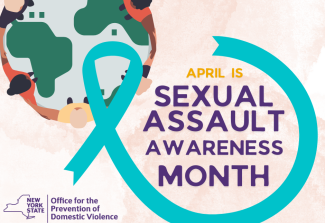SUNY Plattsburgh Finds, Donates Ancient Fossil to NYS Museum
The bones of an ancient harbor seal, discovered accidentally by SUNY Plattsburgh geology students near Lake Champlain, have been donated to the geology collections of the New York State Museum. Jake McAdoo and his fellow students were collecting mud samples at the site of the old Plattsburgh Air Force Base on Lake Champlain when McAdoo's shovel hit something hard.
 "Jake said that he thought he hit a railroad spike. Then, he dug further down and
said, 'No, I think it's a bone,'" said Dr. David Franzi, SUNY distinguished teaching
professor of earth and environmental science, who had gone to the site with his students
to lead them in a landslide study for his environmental geology class. "I told him,
'No, it's not a bone,'" said Franzi. "You almost never find bones."
"Jake said that he thought he hit a railroad spike. Then, he dug further down and
said, 'No, I think it's a bone,'" said Dr. David Franzi, SUNY distinguished teaching
professor of earth and environmental science, who had gone to the site with his students
to lead them in a landslide study for his environmental geology class. "I told him,
'No, it's not a bone,'" said Franzi. "You almost never find bones."
But Franzi was wrong. It was a bone, and a very special bone at that.
Dr. Robert Feranec, curator of vertebrate paleontology at the State Museum, verified that the fossilized bones belong to a harbor seal. He believes they date back to the existence of the Champlain Sea, during the end of the last glacial cycle about 10,000 to 12,000 years ago.
According to Feranec, the bones that have now been uncovered at the site include fibula, tibia, four vertebrae, a jaw bone and what may be ankle and foot bones.
"Seal fossils are a pretty rare find for New York," said Feranec. "We only have two single fossil specimens in the State Museum collections now, so this find of about 15 bones, including the jaw, is significant."
Feranec said the next steps are to carbon date the fossils and conserve them before placing them in the New York State Museum's permanent collections. They then will be available for research, as well as for exhibits and education.

Franzi said his students were very excited about the find, which relates peripherally to what they are learning in the classroom. For students in his sedimentology and geomorphology classes, however, there is a direct connection, and, according to Franzi, the find helps bring his subject to life.
The other students on the field trip with McAdoo and Franzi were Brian Gamache, Zachary Irwin, Katherine Bazan, Jacob Barnhart, Jason Klein and Gregory Colucci.
SUNY Plattsburgh (www.plattsburgh.edu
) offers more than 60 majors and a wide range of special programs that prepare graduates
for professional life and advanced studies through a foundation in liberal arts and
an experience that celebrates excellence, ethical values, lifelong learning and responsible
citizenship in a global community. The college has been recognized two years in a
row by Kiplinger's Personal Finance magazine as one of the "Top 100 Values in Public
Colleges" and has been named among the top master level schools in the North "America's
Best Colleges" by U.S. News & World Report.
The New York State Museum is a program of the New York State Education Department's
Office of Cultural Education. Founded in 1836, the Museum has the longest continuously
operating state natural history research and collection survey in the U.S. Located
on Madison Avenue in Albany, the Museum is open daily from 9:30 a.m. to 5 p.m. except
on Thanksgiving, Christmas and New Year's Day. Admission is free. Further information
can be obtained by calling 518-474-5877 or visiting the museum website at www.nysm.nysed.gov
.
News

SUNY Recognizes Two Plattsburgh Seniors for Excellence in Academics, Leadership

Sexual Assault Awareness Month Events Planned Throughout April
‘Day of Visibility’ Recognizes, Highlights Members of Transgender Community
SBE Teams with CVPH Medical Center to Train Management Personnel
